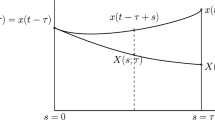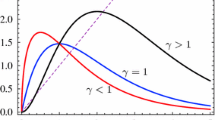Abstract
I explore the nonlinear behavior of a model in which the number of adults in each year is the sum of recruitment (which depends nonlinearly on adult abundanceT years in the past) and a constant fraction (survival) of adults in the previous year. Adding even a small amount of age structure to the semelparous version of this model (by increasing adult survival from zero) is stabilizing in that: (1) it shifts the value of slope at which the linearized model becomes unstable about the equilibrium to a lower value; and (2) it stretches the pattern of period doubling bifurcations so that bifurcations occur at much lower values of the slope. For the iteroparous case with a maturation and survival pattern reasonably typical of long-lived organisms, the period of cycles or quasi-cycles produced increases continuously as the slope of the stock-recruitment function decreases. The possibility of arbitrarily long cycles is not predicted by the linear theory, and has important practical implictions for analyses of cyclic populations. Both truncation of the age structure and an upper limit on recruitment seem to remove this gradual increase in period. However, the former can give rise to doubling of the period. Although the nonlinear behavior is not analysed in detail, a qualitative interpretation of the behavior of this model in terms of population inertia seems to explain the behavior observed in these numerical simulations.
Similar content being viewed by others
Literature
Allen, K. R. 1963. Analysis of stock-recruitment relations in Antarctic fin whales.Cons. int. l'Explor. Mer-Rapp. et Proc.-Verb. 164, 132–137.
Beddington, J. R. 1978.On the dynamics of Sei whales under exploitation. Report of the International Whaling Commission Sc/29/Doc 7, pp. 169–172.
Bence, J. R. and R. M. Nisbet. 1989. Space-limited recruitment in open systems: the importance of time delays.Ecology 70, 1434–1441.
Bergh, M. O. and W. M. Getz. 1988. Stability of discrete age structured and aggregated delay difference population models.J. math. Biol. 26, 551–581.
Beverton, R. J. H. 1963. Maturation, growth and mortality of clupeid and engraulid stocks in relation to fishing.Cons. Perm. int. Explor. Mer, Rapp. P.-V. Reun. 154, 44–67.
Botkin, D. B. and R. S. Miller. 1974. Mortality rates and survival of birds.Am. Nat. 108, 181–192.
Botsford, L. W. 1981. Comment on cycles in the northern California Dungeness crab population.Can. J. Fish. Aquat. Sci. 38, 1295–1296.
Botsford, L. W. 1986a. Population dynamics of the Dungeness crab (Cancer magister). InNorth Pacific Workshop on Stock Assessment and Management of Invertebrates, (Eds) G. S. Jamieson and N. Bourne, pp. 140–153. Canadian Special Publication on Fisheries and Aquatic Sciences, 92.
Botsford, L. W. 1986b Effects of environmental forcing on age-structured populations: northern California Dungeness crab (Cancer magister) as an example.Can. J. Fish. Aquat. Sci. 43, 2345–2352.
Botsford, L. W. 1991. Individual state structure in population models. InIndividual-based Approaches in Ecology: Concepts and Models. New York: Routledge, Chapman and Hall.
Botsford, L. W. and D. E. Wickham. 1978. Behavior of age-specific, density-dependent models and the northern California Dungeness crab (Cancer magister) fishery.J. Fish. Res. Bd Can. 35, 833–943.
Botsford, L. W. and R. C. Hobbs. 1991. Population Dynamics of the Dungeness Crab (Cancer magister) II. Submitted to ICES Rapp.
Clark, C. W. 1976. A delayed-recruitment model of population dynamics, with an application to baleen whale populations.J. math. Biol. 3, 381–391.
Cushing, J. M. 1980. Model stability and instability in age structured populations.J. theor. Biol. 86, 709–730.
Diekmann, O., R. M. Nisbet, W. S. C. Gurney and F. van den Bosch. 1986. Simple mathematical models for cannibalism: a critique and a new approach.Math. Biosci. 78, 21–46.
Ellner, S. 1989. Inferring the causes of population fluctuations (or chaos meets data in population ecology). InMathematical Approaches to Problems in Resource Management and Epidemiology. C. Castillo-Chavez, S. A. Levin and C. A. Shoemaker (Eds), pp. 286–307. New York: Springer-Verlag.
Frauenthal, J. C. 1975. A dynamic model for human population growth.Theor. pop. Biol. 8, 64–73.
Goh, B. S. and T. T. Agnew. 1978. Stability in a harvested population with delayed recruitment.Math. Biosci. 42, 187–197.
Guckenheimer, J., G. Oster and A. Ipaktchi. 1977. The dynamics of density dependent population models.J. math. Biol. 4, 101–147.
Hassel, M. P., J. H. Lawton and R. M. May. 1976. Patterns of dynamical behavior in single species populations.J. Anim. Ecology 45, 471–486.
Hastings, A. 1984. Age dependent predation is not a simple process. II. Wolves, ungulates and a discrete time model for predation on juveniles with a stabilizing tail.Theor. Popul. Biol. 26, 271–282.
Hobbs, R. C. and L. W. Botsford. 1989. Dynamics of an age-structured prey with density- and predation-dependent recruitment: the Dungeness crab and a nemertean egg predator worm.Theor. Popul. Biol. 36, 1–22.
Horwood, J. W. and J. A. Shepherd. 1979. The sensitivity of age-structured populations to environmental variability.Math. Biosci. 57, 59–82.
Levin, S. A. 1981. Age structure and stability in multiple-age spawning populations. InRenewable Resource Management, T. L. Vincent and J. Skowrovski (Eds), pp. 21–45. New York: Springer-Verlag.
Levin, S. A. and R. M. May. 1976. A note on difference-delay equations.Theor. Popul. Biol. 9, 178–187.
Levin, S. A. and C. P. Goodyear. 1980. Analysis of an age-structured fishery model.J. Math. Biol. 9, 245–274.
May, R. M. 1976.Theoretical Ecology: Principles and Applications. Philadelphia: Saunders.
May, R. and G. F. Oster. 1976. Bifurcations and dynamic complexity in simple ecological models.Am. Nat. 110, 573–599.
Morris, W. F. 1990. Problems in detecting chaotic behavior in natural populations by fitting simple discrete models.Ecology 71, 1849–1862.
McKelvey, R. and D. Hankin. 1981. Reply to comment on cycles in the northern California Dungeness crab population.Can. J. Fish. Aquat. Sci. 1296–1297.
McKelvey, R., D. Hankin, K. Yanosko and C. Snygg. 1980. Stable cycles in multistage recruitment models: an application to the northern California Dungeness crab (Cancer magister) fishery.Can. J. Fish. Aquat. Sci. 37, 2323–2345.
O'Neill, R. V., R. H. Gardner and D. E. Weller. 1982. Chaotic models as representations of ecological systems.Am. Nat. 120, 259–263.
Reed, W. J. 1983. Recruitment variability and age structure in harvested animal populations.Math. Biosci. 65, 239–268.
Ricker, W. E. 1954. Stock and recruitment.J. Fish. Res. Bd Can. 11, 559–623.
Roughgarden, J., Y. Iwasa and C. Baxter. 1985. Demographic theory for an open marine population with space-limited recruitment.Ecology 66, 54–67.
Swick, K. E. 1981. Stability and bifurcation in age-dependent population dynamics.Theor. Popul. Biol. 20, 80–100.
Author information
Authors and Affiliations
Rights and permissions
About this article
Cite this article
Botsford, L.W. Further analysis of Clark's delayed recruitment model. Bltn Mathcal Biology 54, 275–293 (1992). https://doi.org/10.1007/BF02464834
Received:
Revised:
Issue Date:
DOI: https://doi.org/10.1007/BF02464834




